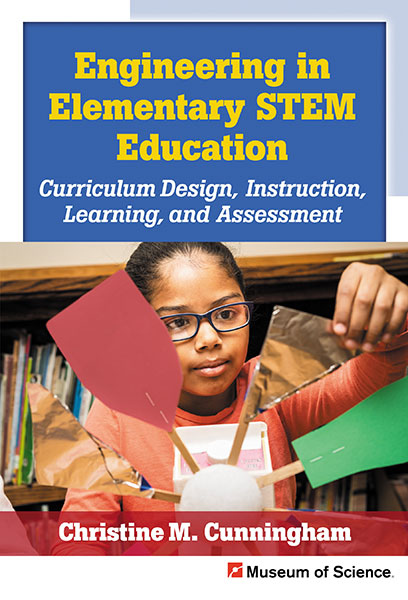Professors: Request an Exam Copy
Print copies available for US orders only. For orders outside the US, see our international distributors.
Christine M. Cunningham, Museum of Science, Boston
Foreword by: Richard A. Duschl
Publication Date: February 16, 2018
Pages: 176

Bolstered by new standards and new initiatives to promote STEM education, engineering is making its way into the school curriculum. This comprehensive introduction will help elementary educators integrate engineering into their classroom, school, or district in age-appropriate, inclusive, and engaging ways. Building on the work of a Museum of Science team that has spent 15 years developing elementary engineering curricula, this book outlines how engineering can be integrated into a broader STEM curriculum, details its pedagogical benefits to students, and includes classroom examples to help educators tailor instruction to engage diverse students. Featuring vignettes, case studies, videos, research results, and assessments, this resource will help readers visualize high-quality elementary engineering and understand the theoretical principles in context.
Book Features:
Christine M. Cunningham is founding director of Engineering is Elementary and a vice president of the Museum of Science, Boston.
"The book will appeal to preservice teachers who are just beginning to develop their teaching pedagogies and to those more veteran teachers who want to freshen their instructional methodology."
—Teachers College Record
"an exceptional resource...the slightly auto‐biographical tone might be highly appreciated by general audience and in fact makes it a welcome reading for teachers... It will inspire and encourage readers to appreciate the “E” in STEM education and explore its benefits towards preparing a next generation of citizens."
—Science Education
“Wondering how to infuse engineering into your teaching and curriculum? Want to understand how you can include the 'E' in STEM education? Here’s the book for you! Christine Cunningham has designed and structured a text that addresses these and other frequently asked questions by teachers and administrators concerning engineering in the elementary classroom. With the aplomb and persistence of an engineer, Christine has considered the problem, developed a process to solve it, then implemented, evaluated, iterated and adjusted the curriculum, instruction, and assessment models until ultimately finding a solution. Engineering in Elementary STEM Education is that solution.”
—From the Foreword by Richard A. Duschl, Waterbury Chair Professor, Penn State University
“We have put the principles and frameworks from Engineering in Elementary STEM Education into practice and to great success! Schools or districts looking to introduce engineering in ways that enhance science and mathematics learning can use the inclusive teaching strategies and concrete real-world examples in this book to innovate for the reality of today’s classrooms.”
—Linda Curtis-Bey, executive director of STEM, NYC Department of Education
“If you care about meaningful and equitable ways to integrate the 'E' in STEM education, this should be your first resource. Grounded in her decades-long, distinguished career in engineering education, Dr. Christine Cunningham lays out an innovative, ambitious, and achievable vision for elementary school engineering that engages all students. She provides vivid classroom examples, design principles based on sound research, and accessible resources so that all stakeholders will find inspiration to become catalysts for change in the STEM educational contexts they work in.”
—Heidi Carlone, Hooks Distinguished Professor of STEM Education, The University of North Carolina at Greensboro
Foreword by Richard A. Duschl
Acknowledgments
Introduction
PART I: INTRODUCING ENGINEERING TO ELEMENTARY EDUCATION
1. Why Make Engineering Part of Elementary Instruction? Why Elementary Engineering?
2. Putting the Spotlight on the “E” in STEM Education
STEM Disciplines and Definitions
STEM in K-12 Schools – Together but Not (Yet) Equal
Relationships Between S, T, E, and M in Elementary Classrooms
Integrating Science, Engineering, and Mathematics in an Elementary Classroom
PART II: CONSIDERATIONS FOR CURRICULUM DESIGN, INSTRUCTION, AND LEARNING
3. Core Engineering Concepts: What Does Engineering Look Like in the Elementary Classroom?
Core Engineering Concept: Engineers Use an Engineering Design Process
Core Engineering Concept: Materials and Their Properties
Core Engineering Concepts in the Classroom: First Graders Design Hand Pollinators
4. Engaging in Authentic Engineering Work
Engineering in NGSS: Out of the Shadows but Not in the Limelight
NGSS Engineering Practices
Engineering Habits of Mind: Putting Engineering in the Spotlight
5. Engineering Design Principles for Inclusivity
Category 1: Set Learning in a Real-World Context
Category 2: Present Design Challenges That Are Authentic to Engineering Practice
Category 3: Scaffold Student Work
Category 4: Demonstrate That "Everyone Engineers" and Everyone Can Engineer
6. Teaching Engineering
Teacher 1: "I Don’t Have Any Extra Time!"
Teacher 2: "There Are so Many Materials to Prepare!"
Teacher 3: "How Am I Going to Manage My Students’ Varied, Creative Designs?"
Teacher 4: "My Students Won’t Like It When Their Designs Don’t Work"
Teacher 5: "I Don’t Know How to Grade My Students on Engineering"
Teacher 6: "I Have Kids in My Class That Will Be Left Behind."
PART III: LOOKING TOWARD THE FUTURE
7. Impacts of Engineering Education
Impacts on Students
Engineering in Classrooms
Impacts on Teachers
Impacts on Schools
8. Conclusion: Engineering Engineering Education
Ask
Imagine
Plan
Create
Improve
References
Index
About the Author
2017 Harold W. McGraw, Jr. Prize in Education
Go here for videos of elementary classroom engineering and other instructional resources.
Professors: Request an Exam Copy
Print copies available for US orders only. For orders outside the US, see our international distributors.